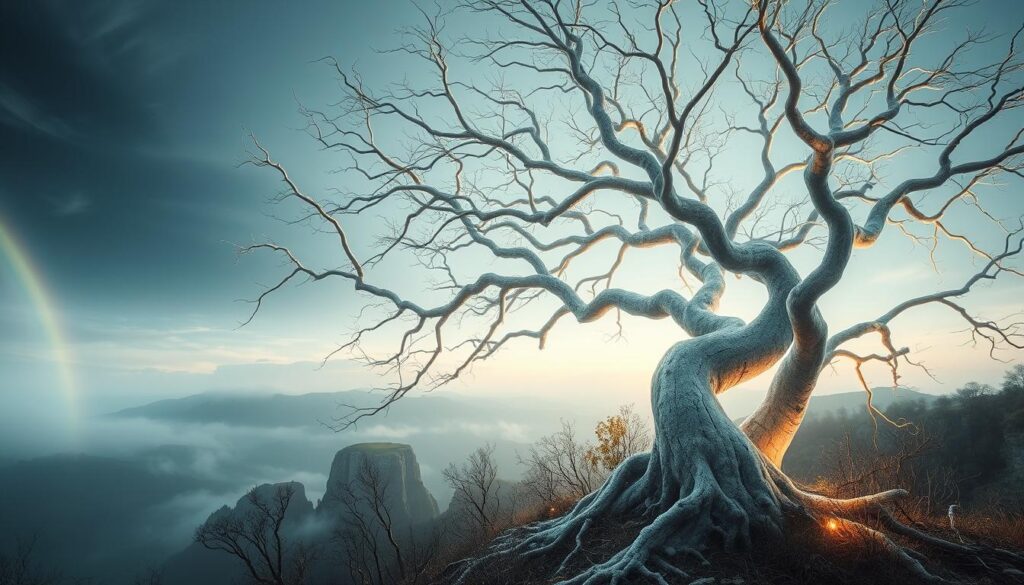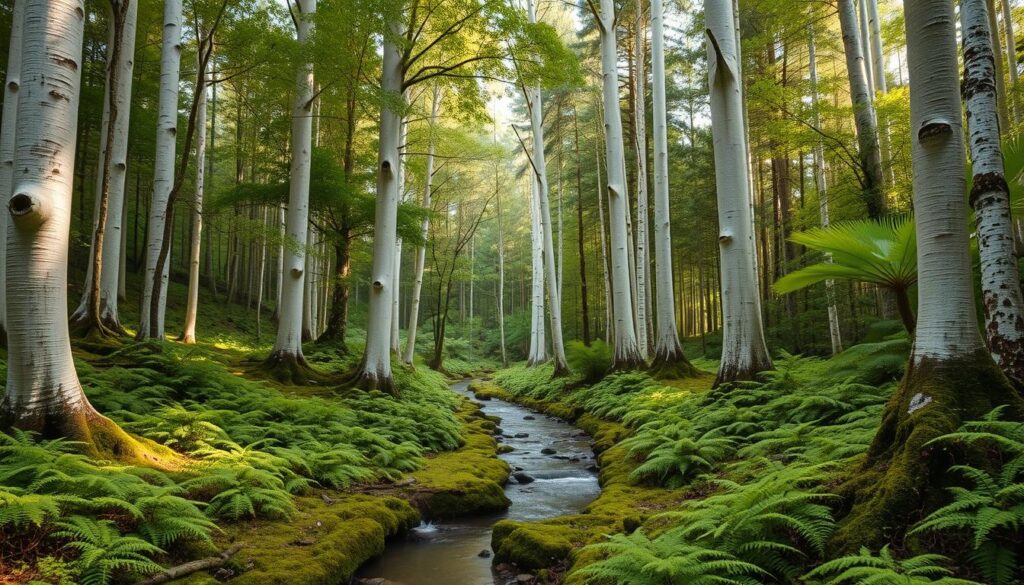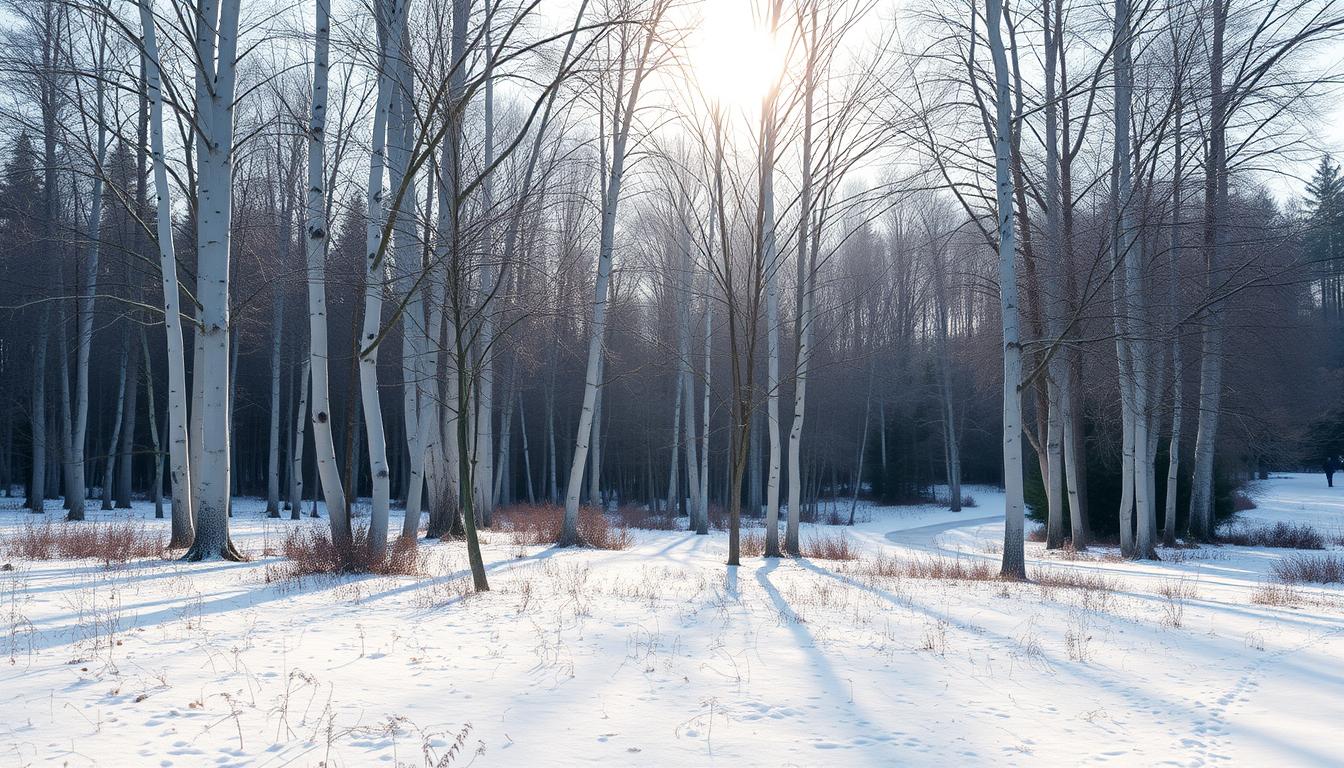Imagine walking through a garden with white bark trees that shine like sculptures. These trees are not just plants; they’re living artworks. They turn your landscape into a breathtaking sight.
White-barked trees do more than look good. They add character to gardens, parks, and cities. Whether you’re a gardener or a landscaping fan, these trees make your outdoor spaces stand out.
From the Trembling Aspen to the Himalayan Birch, each tree has its own story. Their elegant trunks add interest all year. They make any landscape design pop.
Table of Contents
Understanding the Beauty of White-Barked Trees
White-barked trees like quaking aspen and paper birch are nature’s living artwork. They transform landscapes with their stunning visual appeal. These trees are unique botanical treasures, prized for their distinctive characteristics.
The beauty of white-barked trees goes beyond looks. They offer remarkable visual experiences all year, especially in winter, when their bright bark stands out against the snow and darker vegetation.
Visual Impact in Landscaping
White-barked trees are exceptional architectural elements in outdoor spaces. The quaking aspen and paper birch bring unique benefits:
- Bright white bark that creates striking color contrast
- Smooth texture that reflects light beautifully
- Natural architectural interest in garden designs
Seasonal Interest and Contrast
These trees create year-round visual drama. In winter, their luminous white bark is a dramatic sight. Summer brings delicate leaves that complement their distinctive trunk coloration.
Environmental Benefits
White-barked trees like the paper birch have crucial ecological roles. They provide a habitat for wildlife, support local biodiversity, and contribute to environmental health.
By choosing white-barked trees, you enhance your landscape while supporting complex ecological systems that sustain local wildlife and plant communities.
Popular Trees with White Bark for Your Garden
White-barked trees can make your garden look amazing. The American beech and white oak are top picks for gardeners. They offer unique and eye-catching tree varieties.
- American Beech: A native species with smooth, silvery-gray bark that provides elegant texture
- White Oak: Known for its distinctive light-colored bark and impressive structural growth
- Betula papyrifera (Paper Birch): Features stunning white bark that peels to reveal orange-brown layers
- Betula utilis jacquemontii: Offers luminous white bark with golden yellow autumn leaves
These trees add special features to your garden. The American beech has a smooth look that’s interesting all year. White oak adds strength and beauty to big gardens.
When picking white-barked trees, think about a few things:
- Mature height and spread
- Soil and sunlight needs
- How well it adapts to your climate
- Its color changes with the seasons
By adding these trees, your garden can become a beautiful display of nature. From birch’s delicate bark to white oak’s strength, these trees will make your garden stand out.
Native American White Bark Species
White bark trees are amazing sights in the United States. They can be found in mountains and gentle hills. These trees are not only beautiful but also play a big role in nature.
In Native American lands, sycamores and poplars are standout trees. They have special ways of living in tough places.
Northern Climate Varieties
In the north, the Whitebark pine is incredibly tough. It grows well in cold, high places. It even grows in weird shapes called krummholz in very harsh spots.
- Maximum height reaches 29 meters
- Yellow-green needles in fascicle bundles
- Crucial food source for wildlife
Southern Climate Adaptations
In warmer areas, trees with white bark have special ways to handle the heat. Sycamores, for example, have white and tan bark. They grow near rivers and in woods, helping local animals and plants.
Growth Characteristics and Requirements
To grow well, white bark trees need the right soil and water. Poplars and sycamores need different things based on where they come from.
“White bark trees are nature’s living sculptures, adapting and surviving across diverse American landscapes.” – Forest Ecology Research Team
When picking white bark trees for your yard, think about the local weather, soil, and sunlight. This will help them grow strong and healthy.
Exotic White Bark Trees for Unique Landscapes

Discover the magic of exotic white bark trees. They can turn your landscape into a breathtaking visual masterpiece. The ghost tree is a remarkable addition to warm-climate gardens. It offers an extraordinary aesthetic appeal that captures attention.
Some of the most captivating exotic white bark trees include:
- Himalayan Birch: Featuring snowy white peeling bark that reveals stunning yellow undertones
- Ghost Gum Tree: A spectacular specimen with smooth, luminescent white bark
- Tibetan Cherry: Presenting a unique metallic bark with white floral accents
When selecting exotic white bark trees, consider these key characteristics:
| Tree Species | Mature Height | Growth Rate | Bark Characteristics |
|---|---|---|---|
| Himalayan Birch | 40-60 feet | 1.5-2 feet/year | Snowy white peeling bark |
| Ghost Gum Tree | 50-70 feet | 2 feet/year | Smooth, creamy white bark |
| Tibetan Cherry | 30-50 feet | 1.5 feet/year | Metallic white-red bark |
Your landscape can benefit from these unique ghost tree varieties. They create visual drama and year-round interest. These exotic trees not only provide stunning aesthetics but also support local wildlife and enhance garden biodiversity.
Ideal for gardeners seeking something extraordinary, exotic white bark trees offer an unparalleled opportunity. They allow you to craft a landscape that stands out from traditional green spaces.
Maintaining White-Barked Trees Throughout Seasons
White-barked trees, like the white willow, need special care to keep their beauty and health all year. Knowing how to care for them in each season helps protect them from the environment.
In winter, it’s important to watch over white willow and other white-barked trees. They face challenges from cold temperatures and potential damage.
- Remove snow gently from branches
- Use tree wraps to protect trunks from frost cracks
- Apply organic mulch around tree bases
- Water trees when temperatures are above 40°F
It’s key to preventing sunscald on white-barked trees. Sunscald happens when sudden temperature changes harm bark cells. This is especially true on the south sides of trees.
| Season | Maintenance Task | Purpose |
|---|---|---|
| Winter | Tree Wrapping | Prevent Bark Damage |
| Spring | Pruning | Remove Winter Damage |
| Summer | Mulching | Retain Soil Moisture |
| Fall | Reduce Fertilization | Prevent Tender Growth |
Getting help from a professional arborist can spot and fix problems early. This keeps your white willow and other white-barked trees healthy and looking great all year.
Best Growing Conditions for White Bark Species
To grow trees with white bark, you need to know their special needs. Each type of tree has its own needs for healthy growth and beauty in your garden.

When picking trees with white bark, look closely at their growing needs. These trees can make your garden look amazing with their unique look.
Soil Requirements
White bark trees like different soils based on their type. Here are some key points:
- They prefer slightly acidic soil with pH levels between 5.0 and 6.4
- They need soil that drains well
- Some can handle moist areas near water
Climate Considerations
White bark trees are very adaptable to different climates. Their ability to thrive varies by type:
- They grow well in Zones 2-9
- Some do great in very cold, high places
- Some can handle windy, tough spots
Watering Needs
It’s important to water white bark trees correctly. Here’s what to do:
- Water them about 1 inch a week in the first year
- Water less in later years
- Change based on your area’s weather and tree type
Pro tip: Always check the specific needs of your chosen white bark tree species for the best growth and life span.
Design Tips for Incorporating White Bark Trees
White bark trees like quaking aspen and paper birch can make your landscape stunning. They add unique texture and brightness. This can make your garden look amazing.
When designing with white bark trees, consider these essential approaches:
- Create striking focal points using quaking aspen as centerpiece specimens
- Group paper birch trees to generate visual depth and interest
- Use white bark trees to brighten shaded garden areas
- Highlight bark texture with strategic landscape lighting
Where you place these trees matters a lot. Paper birch looks great near darker evergreen trees. Quaking aspen does well in small groups, making your garden look like a forest.
| Tree Type | Best Placement | Visual Effect |
|---|---|---|
| Quaking Aspen | Woodland edges | Bright, dynamic texture |
| Paper Birch | Near water features | Elegant, reflective quality |
Choose plants that go well with the white bark. Plants that like shade can make the trees look even better. Ornamental grasses or small shrubs add texture and interest.
White bark trees are more than just pretty. They change with the seasons, keeping your garden interesting all year.
Common Problems and Solutions for White Bark Trees
White bark trees, like the American beech and white oak, face unique challenges. It’s important to understand these issues to keep your trees healthy and beautiful all year.
To protect your white bark trees, you need a detailed plan. This plan should tackle problems early to prevent serious damage to your trees.
Disease Prevention Strategies
White bark trees can get sick, which can harm their health and structure. To prevent this, follow these steps:
- Regularly check your trees for early signs of disease
- Prune your trees correctly
- Make sure there’s enough air around your trees
- Watch out for fungal infections like powdery mildew
Pest Management Techniques
Keeping pests away is key to protecting your white oak and American beech trees. Here are some effective ways to do this:
- Find out which pests are common in your area
- Choose eco-friendly pest control methods
- Quickly remove any pests you see
- Use the right treatments for your tree type
Environmental Stress Management
White bark trees can get stressed from their environment. To help them, do the following:
- Keep them safe from extreme temperatures
- Water them right during dry spells
- Keep them away from city pollution
- Give them extra nutrients when needed
Professional arborists can give you expert advice on caring for your white bark trees. They can help keep your pets looking great and healthy for a long time.
Companion Plants for White-Barked Trees
Choosing the right plants can make your white-barked trees stand out. Sycamore and poplars can become the stars of your garden. Knowing which plants go well with them will make your garden look amazing.
When picking plants for sycamore and poplars, look for these great options:
- Artemisias: Their silvery leaves look great next to white bark
- Catmint: It adds rich purple flowers that make the trees look even better
- Coral bells: They come in many colors and are easy to care for
The Arizona Sycamore has a special bark that looks great in wet areas. It loves water, which is good for plants that like the same conditions.
“The right plant combinations can elevate a simple landscape into a breathtaking garden design.” – Landscape Design Expert
For poplars, choose plants that:
- Do well in partial shade
- Match the tree’s bark color
- Like the same amount of water
Your plan for white-barked tree friends should look good and be good for the environment. This way, your outdoor space will be both beautiful and healthy.
Conclusion
Trees with white bark can make any landscape look amazing. From the elegant ghost tree to native species, they add beauty to outdoor spaces. Their striking look creates interest all year, especially against green and winter scenes.
These trees are not just pretty; they’re good for the environment, too. They help ecosystems, provide homes for wildlife, and increase biodiversity. Choosing the right tree for your area can make your garden stand out.
Exploring white bark trees lets you create landscapes that are both good for the planet and beautiful. Whether you want a ghost tree for a modern garden or a native species for a green space, there are many options. These trees open up endless possibilities for creative outdoor design.
Starting your journey with white-barked trees is a chance to change your outdoor spaces. With the right choice and care, these trees can turn your landscape into a work of art. They bring beauty, benefits to the environment, and a special connection to nature.
FAQ
What are the most popular white-barked tree species for landscaping?
Popular white-barked trees include quaking aspen, paper birch, and American beech. Sycamore and white willow are also favorites. These trees add beauty with their white or light bark, making gardens stand out.
Are white-barked trees suitable for all climate zones?
White-barked trees fit different climates. Poplars and sycamores grow well in many parts of the U.S. Choose a tree that fits your local climate and soil.
How do I care for white-barked trees throughout the year?
Year-round care is key. Prune, fertilize, and protect the bark. Watch for watering needs and soil health. Each tree has its own needs, so research yours.
Can white-barked trees provide environmental benefits?
Yes, they offer many benefits. They support wildlife, improve soil, and add beauty. Trees like white oak and quaking aspen are especially good for the environment.
What are some common problems with white-barked trees?
Common issues include bark damage and pests. Some trees may struggle with disease or extreme weather. Regular care can help prevent these problems.
How do I choose companion plants for white-barked trees?
Choose plants that contrast with the tree’s bark. Consider color, texture, and shade tolerance. Plants like ground covers or perennials can add interest all year.
Are there exotic white-barked tree species I can use in landscaping?
Yes, exotic trees like the ghost gum can add uniqueness. But, they need specific conditions and climates. Talk to local experts to find the right exotic trees for your area.

